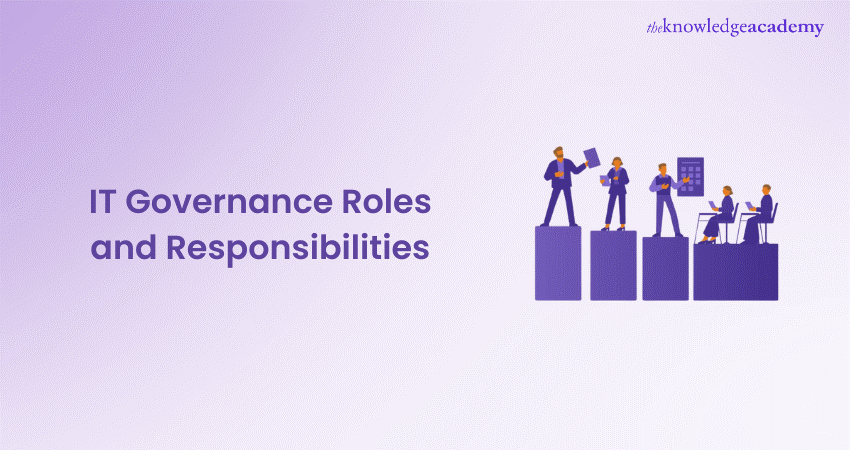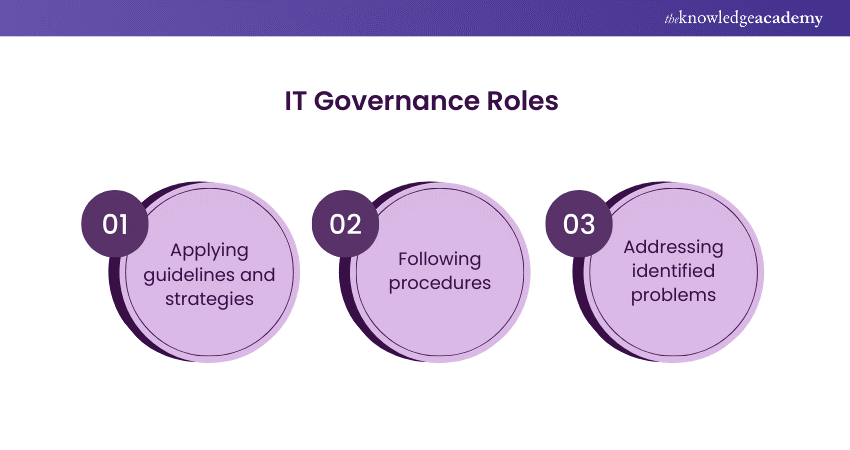We may not have the course you’re looking for. If you enquire or give us a call on +44 1344 203 999 and speak to our training experts, we may still be able to help with your training requirements.
Training Outcomes Within Your Budget!
We ensure quality, budget-alignment, and timely delivery by our expert instructors.

Are you an IT Security and Data Protection professional working in the IT Governance domain? Perhaps you are a novice in the field and looking to expand your knowledge base and enhance your career opportunities. Understanding the IT Governance Roles and Responsibilities are paramount to this endeavour and will make your journey much easier.
In this blog, we delve into the IT Governance roles and responsibilities within an organisation. From establishing IT objectives to ensuring regulatory compliance, we provide a detailed breakdown of the key roles and responsibilities involved in governing IT activities. Keep reading!
Table of Contents
1) IT Governance Roles
a) Applying guidelines and strategies
b) Following procedures
c) Addressing identified problems
2) IT Governance Responsibilities
a) Establishing IT objectives
b) Creating and implementing the IT Governance Framework
c) Establishing ethics within the IT department
d) Nurturing the culture of the IT organisation
e) Ensuring adherence to regulations
3) Conclusion
IT Governance Roles
IT governance roles encompass establishing IT objectives aligned with business goals, creating and implementing governance frameworks, fostering ethics and culture, ensuring compliance, and driving organisational success through effective management of IT resources and activities. These roles are essential for aligning IT with business objectives and optimising IT performance.

1) Applying guidelines and strategies
IT Governance operates by implementing well-sustained internal standards and authoritative practices throughout an organisation. It entails converting IT strategies into functionable IT projects and adjusting the IT spending to general business plans. Frameworks like Control Objectives for Information and Related Technologies (COBIT) or Information Technology Infrastructure Library (ITIL) provide IT Governance members confidence that the organisation's IT operations adhere to industry's established norms. They actually are instrumental in the formation and execution of IT Governance policies, the implementing of procedures, and the development of standards, so that the organisation works more efficiently and properly.
2) Following procedures
In the regulations of IT Governance positions, staff members should be in charge of the regular adherence to uniform policies and rules to make the IT operation highly effective. It covers the creation of well-defined processes for IT project management, changes control, incident response, and monitoring of compliance.
By following the already established procedures, organisations maintain consistency, reliability and accountability in their IT practices. The IT Governance personnel supervise this process. Subsequently, they ensure that these procedures are strictly followed in an organisation. These personnel play a vital role in creating and implementing policies and controls to identify and respond to risks, protect assets and maintain their firm’s regulatory compliance.
Elevate your Cybersecurity career with our comprehensive Certified Information Security Manager (CISM) Training — Join now and become a certified expert!
3) Addressing identified problems
In the contemporary IT Governance context, which involves problem-solving within the sphere of information technology, employees take up this role. It entails undertaking effective surveys and inspections that will lead to a determination of weaknesses, loopholes, or non-compliance; IT Governance professionals perform analysis of data and metrics to find the root cause of the problem and develop approaches that could successfully address the problem by remediating them.
They engage in conversations with colleagues from all departments of the company, to come up with solutions to current issues, re-engineer the processes, and increase the IT performance. Through anticipatory resolution of any detected issues, IT Governance personnel promote better and healthy IT systems, systems operation, and security. Firstly, they ensure that the culture of constant change and innovation is captured and preserved within the organisation.
Be more mindful about your data privacy, sign up for our Data Privacy Awareness Course - register now.
IT Governance Responsibilities
IT governance responsibilities encompass defining IT objectives aligned with business goals, establishing governance frameworks, fostering ethical conduct, nurturing organisational culture, and ensuring regulatory compliance. It involves creating structures, processes, and controls to optimise IT resource utilisation, mitigate risks, and drive organisational success through effective management of IT activities.
1) Establishing IT objectives
IT Governance duties include defining the desired, measurable and accurate objectives of the IT department in keeping with the strategic choices of the whole organisation. This involves working with C-suite executives and other major shareholders to determine top strategic IT goals, including those related to improving operational efficacy, ensuring Cybersecurity, or leading digital transformation. By means of specific goals IT Governance accomplishes the fact that IT expenditures and projects are illustrated by the way of the contributions and business force.
2) Creating and implementing the IT Governance Framework
The role of IT Governance is designing a comprehensive governance framework that covers all the critical policies, processes, and procedures for the appropriate management of IT assets and usage. Among these are defining the structure of governance, roles, and responsibilities, establishing decision making procedures, and providing controls for risk mitigation and compliance with necessary regulations.
IT Governance sets up a thorough governance structure involving IT Governance which enables strategic alignment of IT activities with business expectations and gives guidance to optimise the IT resources utilisation to the maximum extent.
3) Establishing ethics within the IT Department
IT Governance has immense significance in ensuring ethical behavior and integrity within the entire IT community. This is formed upon promoting the principles and standards of ethics for IT professionals, including confidentiality and respect to user privacy and code of professional conduct.
IT Governance which builds an ethical and integrity culture aids in boosting the trust and credibility of the organisation thereby guarantees that the IT activities are conducted with high ethical standards and accountability.
Solve crimes with just your screen and keyboard. Sign up for our Computer Forensics Foundation Training - Register now
4) Nurturing the culture of the IT organisation
IT Governance is also needed for building a disciplined and team-based culture among the IT staff members. This means fostering collaboration, innovation and a culture of continuous improvement, providing the necessary means for personal development and job advancement. Through the creation of a supportive and inclusive workplace atmosphere, IT Governance enables IT professionals to excel in the performance of their duties, to contribute greatly to the organisation's achievement of its targets and to be the drivers of innovation and excellence in the IT business.
5) Ensuring adherence to regulations
IT Governance is obliged to make sure that IT activities and usages conform with the given laws, regulations, and standards of the industry. This entails tracking regulatory requirements, complying with industry standards and undertaking frequent audits and reviews. This will ensure compliance, and implementing controls and barriers to address compliance risks.
Through the compliance with the regulations, IT Governance prevents the organisation from legal and reputational risks and shows responsibility in ethical and secure IT management.
Build the best Network Security systems, sign up for our Network Defence Training - register now!
Conclusion
In conclusion, mastering IT Governance Roles and Responsibilities is fundamental for professionals navigating the complex IT landscape. By understanding these vital tasks, individuals can effectively steer organizational IT activities, ensuring alignment with objectives and compliance with regulations. Join us on this journey to unlock the potential of IT governance expertise.
Unlock your potential in Cybersecurity with our CISM Training. Join today and advance your career to the next level
Frequently Asked Questions

The four focus areas of IT Governance are Strategic Alignment, Risk Management, Resource Management, and Performance Measurement. These areas ensure that IT activities align with business objectives, mitigate risks effectively, optimise resource allocation, and monitor performance to drive organisational success.

The two main objectives of IT Governance are:
a) Align IT investments with business goals, optimising value creation.
b) Manage IT-related risks effectively, safeguarding the organisation's assets, reputation, and compliance with regulations.

The Knowledge Academy takes global learning to new heights, offering over 30,000 online courses across 490+ locations in 220 countries. This expansive reach ensures accessibility and convenience for learners worldwide.
Alongside our diverse Online Course Catalogue, encompassing 17 major categories, we go the extra mile by providing a plethora of free educational Online Resources like News updates, blogs, videos, webinars, and interview questions. Tailoring learning experiences further, professionals can maximise value with customisable Course Bundles of TKA.

The Knowledge Academy’s Knowledge Pass, a prepaid voucher, adds another layer of flexibility, allowing course bookings over a 12-month period. Join us on a journey where education knows no bounds.

The Knowledge Academy offers various CISA Training, including Information Systems Auditing, Control, and Security courses. These courses cater to different skill levels, providing comprehensive insights into CISA Books.
Whether you are starting your journey or aiming to elevate your Information Security expertise, immerse yourself in our IT Security & Data Protection Blogs to discover more insights!
Upcoming IT Security & Data Protection Resources Batches & Dates
Date
 Certified in Risk and Information Systems Control (CRISC)
Certified in Risk and Information Systems Control (CRISC)
Sat 6th Jul 2024
Mon 29th Jul 2024
Sat 23rd Nov 2024
Mon 9th Dec 2024









 Top Rated Course
Top Rated Course



 If you wish to make any changes to your course, please
If you wish to make any changes to your course, please


